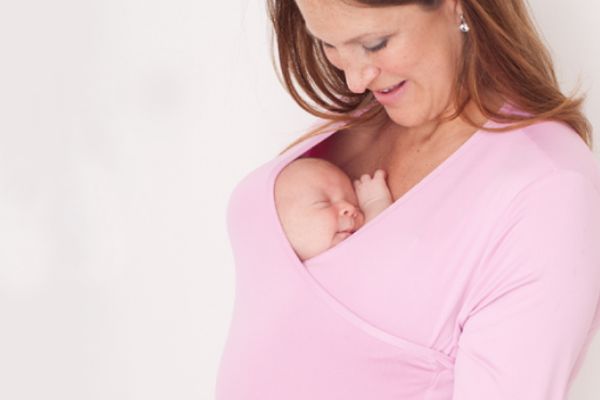The Academy of Pediatrics and the Surgeon General are encouraging moms to practice skin-to-skin immediately after birth and throughout the post partum period. Learn these myths to ensure mom and baby receive all the benefits!
-
Kangaroo Care (KC) and Skin-to-Skin Contact are two different things.
Not Necessarily. KC is the formal practice of Skin-to-Skin Contact where baby is wearing only a diaper, positioned vertically on moms chest, allowing for full bare chest to bare chest contact and nerve stimulation. Skin-to-Skin contact is a more colloquial term for the practice, but it can mean various Skin-to-Skin positions (ie: baby breastfeeding in moms arms, cheek to chest or belly to belly, none of which deliver the benefits of the practice). -
Any amount of time spent Skin-to-Skin delivers physiologic benefits.
False. Baby needs to be held for an uninterrupted 60 minutes to elicit a hormonal cascade delivering all the physical benefits KC offers. -
Kangaroo Care is only for premature babies.
False. It was initially utilized as a life saving practice for preterm infants but there are over 160 research studies on the full-term newborn that documents the need and benefits of KC. It is promoted as an “Essential element of newborn care to save and improve all newborn lives” by UNICEF, Save The Children and World Health organizations. -
Skin-to-skin’s only benefit is bonding.
False. Research has shown bonding is one of many benefits that are received by mom and baby, including accelerated brain development, less colic and crying, better eating and sleeping, improved weight gain and a stronger immune system. (Learn all the benefits here.) -
Kangaroo Care only works when a biological mother provides benefits to her baby.
False. KC can be achieved by any human-to-human touch that triggers nerve stimulation on the front of the chest. This includes dads, grandparents, siblings and adoptive parents. -
Skin-to-Skin is only important immediately following birth.
False. Skin-to-Skin is encouraged immediately after birth, throughout the hospital stay, and well after discharge. Families are encouraged to practice Skin-to-Skin for an uninterrupted 60 minutes during the first 12 weeks and beyond. The Academy of Pediatrics recommends Skin-to-Skin be given as long as possible and as frequently as possible during the post partum period, which is typically defined as the first 3 months of life. -
Kangaroo Care can only be performed in bed.
False. Baby can be held in KC while mom is up on her feet and moving around so long as they are secure, supported, and in the correct KC position. -
Skin-to-skin contact is only for moms that plan to/are breastfeeding.
False. All moms can practice skin-to-skin, regardless of their choice to breastfeed. The benefits received while holding baby in KC occur independently of breastfeeding. The beneficial hormonal cascade does not occur while breastfeeding. -
Swaddling a baby immediately after birth is more conducive to keeping baby warm and calm than in comparison to skin-to-skin contact.
False. When mom holds her baby skin to skin the first hour following birth, the mother and baby exchange sensory information that stimulates and elicits “baby” behavior: rooting and searching for the breast, staying calm, breathing more naturally, staying warm, maintaining their body temperature and blood sugar levels. Babies that are swaddled immediately after birth have a more difficult time seeking out the breast. Furthermore, the mother begins to regulate her babies temperature within minutes of being on her skin. -
Kangaroo Care only provides benefits to baby.
False. Mom receives benefits from Kangaroo Care, too! The same hormonal cascade that is activated in baby’s body, also occurs in mom’s body delivering benefits that include: faster recovery from vaginal/c-section delivery, increased milk production, reduction of stress hormone and less risk for postpartum depression.
See how the NüRoo Pocket provides coverage and mobility to moms practicing skin-to-skin.

